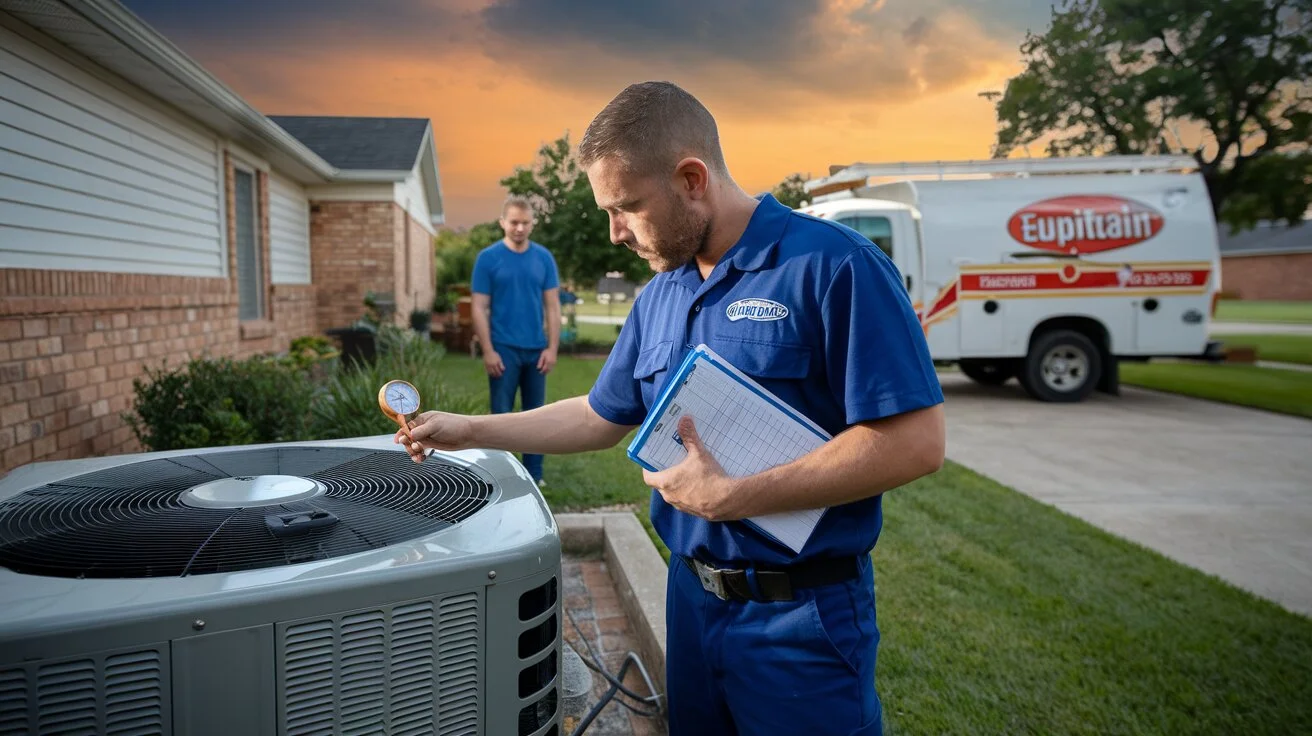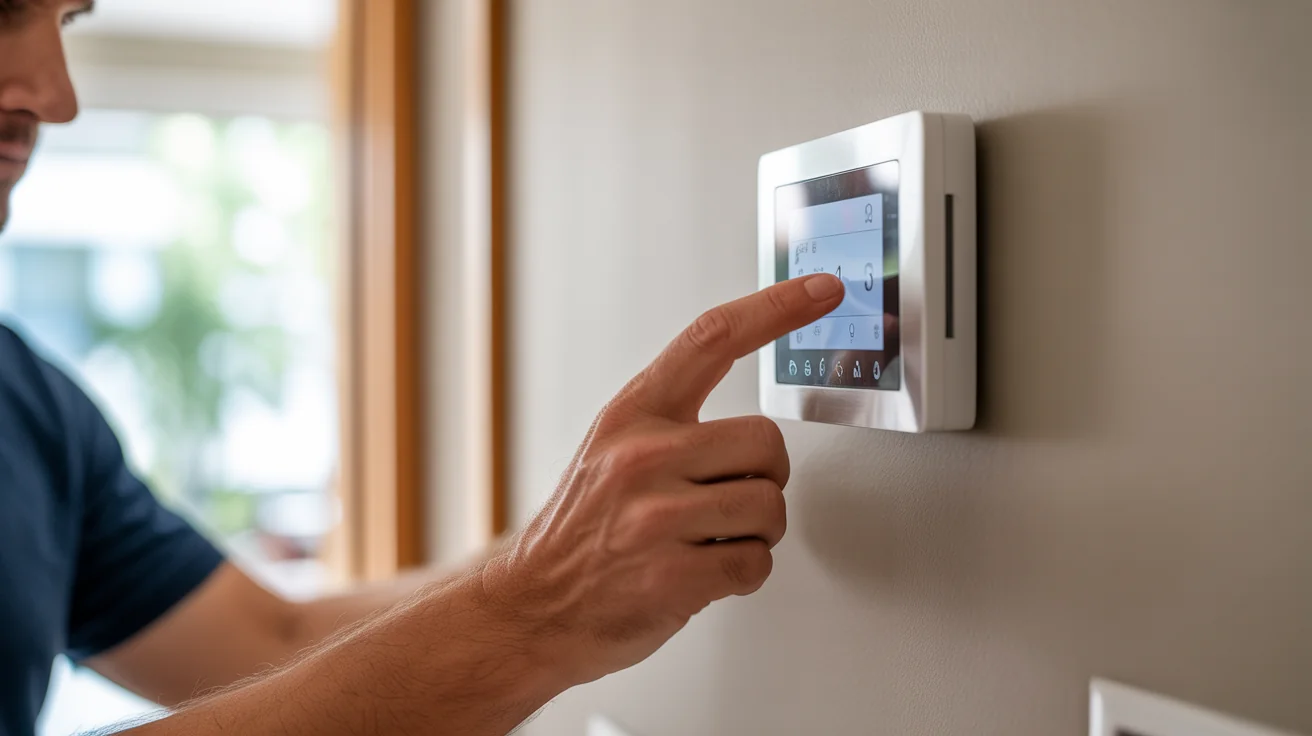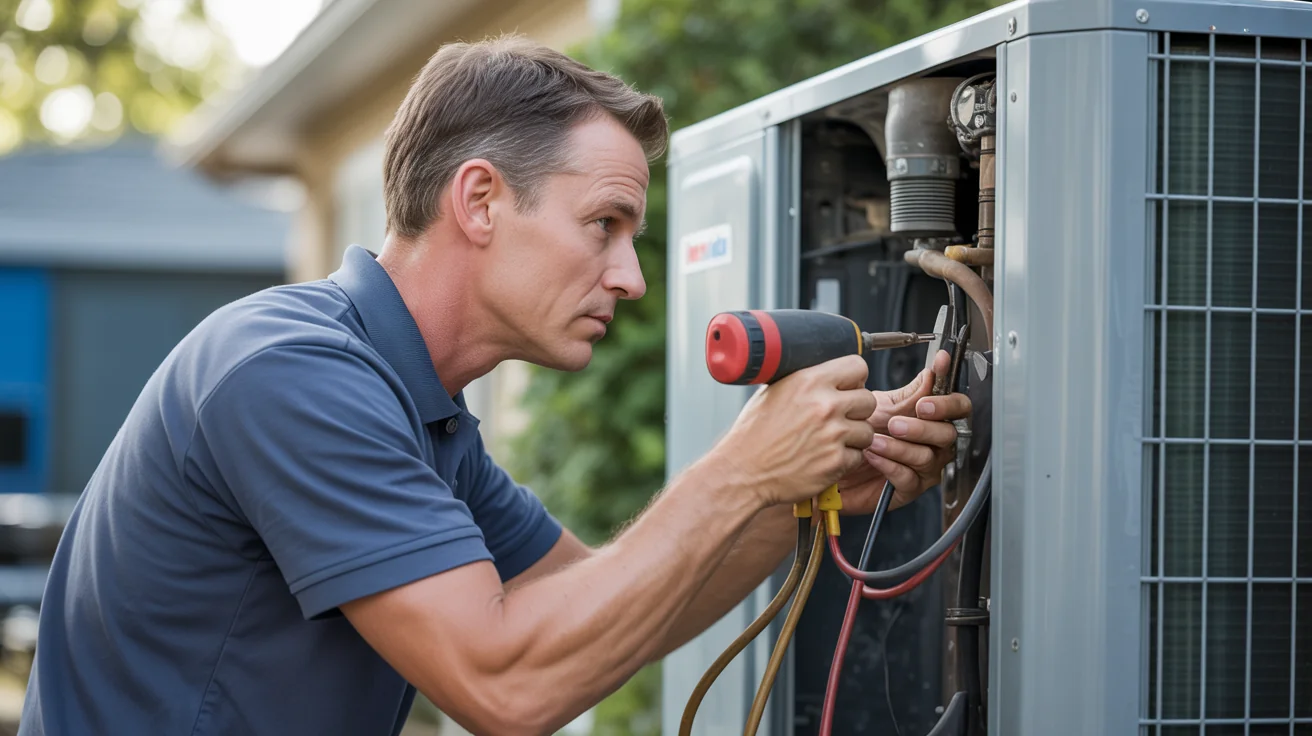AC Not Cooling Emergency: Complete Diagnostic Checklist & 24/7 Response
Emergency AC not cooling response guide for North Texas. Step-by-step diagnostic checklist, professional repair solutions, and guaranteed same-day service.

When Your AC Stops Working in Texas Heat: Emergency Action Plan
Your AC just quit blowing cold air and it’s 98°F outside. I know exactly how you’re feeling right now - that sinking panic when you realize your house is going to turn into an oven. In North Texas, this isn’t just uncomfortable, it can be dangerous.
I’ve been doing emergency AC calls for over 15 years, and I can tell you that sometimes there’s a simple fix you can try before calling for help. But when temperatures climb like they do here, we need to move fast.
IMMEDIATE EMERGENCY SERVICE: (940) 390-5676 - 30-minute response guarantee during heat emergencies
Need professional help now? Our North Texas emergency AC repair specialists are standing by with fully-stocked trucks and 15+ years of cooling emergency experience.
EMERGENCY SAFETY CHECK (Do This First)
Critical Safety Verification
STOP and Check These Dangers: Gas smell near the unit requires immediate evacuation and calling the gas utility at 866-322-8667. Electrical sparking or burning smells mean you should turn off power at the breaker and call an electrician immediately. Water around electrical components requires powering down the system to avoid electrical shock hazards. Carbon monoxide detector alarms demand immediate evacuation, getting fresh air, and calling 911 for emergency response.
Family Safety Assessment: Infants and elderly family members are affected by heat first, so prioritize immediate cooling for these vulnerable individuals. Those with medical conditions including heart, respiratory, or mobility issues need urgent help and should be moved to cooler areas immediately. Pets should be moved to the coolest areas available with adequate water provided for hydration. Air quality concerns include checking for dust, allergens, or poor ventilation that could worsen during cooling system failures.
Immediate Temperature Management
Before Professional Help Arrives:
- Close blinds and curtains to block heat
- Use fans to circulate air (even warm air helps)
- Move family to lowest level of home (heat rises)
- Hydrate frequently with cool water Avoid ice baths or extreme cooling measures is an important factor to consider.
15-MINUTE EMERGENCY DIAGNOSTIC CHECKLIST
Step 1: Thermostat and Power Verification (2 minutes)
Thermostat Check:
- Set to COOL mode (not OFF or HEAT)
- Temperature setting at least 5°F below current room temperature
- Display functioning (if digital, check for error codes) Take photo of thermostat settings and any error messages is an important factor to consider.
Power Verification:
- Check circuit breaker (look for tripped position)
- Verify disconnect switches are ON (both indoor and outdoor units)
- Check for blown fuses in older systems Note: If breaker trips again after reset, STOP and call professional is an important factor to consider.
Step 2: Air Filter and Airflow Inspection (3 minutes)
Filter Assessment:
-
Remove and inspect air filter condition Completely blocked filter causes 70% of cooling failures - learn about proper filter selection and ac maintenance schedules to prevent this.
-
Look for excessive dirt, pet hair, or debris
-
Check if filter is properly sized and installed
Immediate Airflow Tests:
- Hold tissue paper near return vents (should draw toward vent)
- Check supply vents for airflow (should feel air movement)
- Verify all vents are open and unblocked Weak airflow often indicates filter or blower problems - see our ac blowing warm air guide for related airflow issues.
Step 3: Outdoor Unit Assessment (4 minutes)
Visual Inspection Checklist: Unit running: fan spinning, compressor humming normally. Unit silent: no sounds when thermostat calls for cooling. Unit humming: fan not spinning, possible electrical failure. Take photos of any obvious damage or unusual conditions is an important factor to consider.
Environmental Factors:
- Clear area around unit (2-foot minimum clearance)
- Remove debris, leaves, or vegetation blocking airflow
- Check for adequate shade (direct sun reduces efficiency) Blocked outdoor unit causes immediate cooling loss is an important factor to consider.
Step 4: Ice and Water Detection (3 minutes)
Ice Formation Check:
-
Look for ice on visible indoor coil parts
-
Check for frost on refrigerant lines Any ice formation requires immediate system shutdown - follow our complete frozen evaporator coil emergency guide for safe steps.
-
Document ice location and amount with photos
Water Issues:
- Check for water pooling around indoor unit
- Look for water stains on ceiling or walls
- Verify drain pan condition and drainage Water problems indicate frozen coil or drainage failure is an important factor to consider.
Step 5: Performance Testing (3 minutes)
Temperature Assessment:
-
Measure temperature at supply vents with thermometer
-
Compare to room temperature (should be 15-20°F cooler) Less than 10°F difference indicates serious problem is an important factor to consider.
-
Check multiple vents for consistent temperatures
System Response Test:
-
Turn thermostat down 5°F and listen for system startup
-
Time how long before cold air begins flowing No response within 5 minutes indicates electrical/control failure is an important factor to consider.
-
Normal systems respond within 1-2 minutes
EMERGENCY DIAGNOSTIC FLOWCHART
When to Call Immediately vs. Simple Fixes
CALL IMMEDIATELY if you find: No electrical power to indoor or outdoor units requires professional AC repair services to diagnose and restore electrical function safely. Ice formation anywhere on the system means following our frozen coil emergency steps and calling for immediate service. Water leaks or drainage problems need immediate professional attention to prevent property damage and identify system failures. Burning smells or electrical damage require contacting emergency AC repair immediately for safety and system protection. Gas odors near heating components demand immediate evacuation and calling the gas utility for emergency response. Complete system silence when calling for cooling likely indicates electrical failure requiring professional diagnosis.
Possible DIY Fixes (Try First): Dirty filters should be replaced immediately with the proper size following our complete filter selection guide and AC maintenance schedules. Tripped breakers can be reset once, but if the breaker trips again, call a professional to avoid electrical hazards. Blocked vents should be cleared of furniture and debris as proper airflow prevents many cooling issues. Thermostat issues often involve checking batteries and settings, as sometimes the problem is just an incorrect setting. Outdoor unit blockages should be cleared of debris and vegetation as part of regular preventive maintenance.
NORTH TEXAS HEAT EMERGENCY RESPONSE
Understanding Heat Emergency Conditions
Critical Temperature Thresholds: 90°F+ outdoors: ac systems under stress, failures increase. 85°F+ indoors: dangerous for vulnerable occupants. Heat index 105°F+: emergency priority response activated. Multiple day heat waves: equipment stress multiplies.
North Texas Specific Challenges: 100°F+ sustained temperatures push systems beyond design limits. Electrical grid stress causes voltage fluctuations affecting ac operation. High humidity increases apparent temperature and cooling load. Urban heat island effects in dallas-fort worth metroplex add 5-10°f.
Emergency Response Priority System
Priority 1 - Immediate Response (15-30 minutes):
- Temperatures above 100°F with vulnerable occupants
- Complete system failure during heat warnings
- Medical conditions requiring climate control Infants, elderly, or health-compromised residents is an important factor to consider.
Priority 2 - Same-Day Response (1-4 hours):
- Partial cooling failure during extreme heat
- System running but inadequate cooling capacity
- Electrical or safety concerns Commercial properties with occupant safety issues is an important factor to consider.
PROFESSIONAL EMERGENCY REPAIR PROCESS
What Our Emergency Technicians Do
First 15 Minutes On-Site:
- Complete safety assessment and hazard identification
- Advanced diagnostic testing with professional equipment
- Root cause identification using specialized tools Immediate temporary cooling solutions if possible is an important factor to consider.
Emergency Repair Procedures:
-
Professional-grade parts inventory on every truck
-
Same-day repair completion for common failures
-
Temporary cooling solutions during extended repairs Insurance documentation and coordination assistance is an important factor to consider.
-
Complete repair cost transparency - see our North Texas AC repair cost guide
Emergency Repair Timeline and Costs
Common Emergency Repairs: Capacitor failure: $200-$400, 30-60 minute repair. Contactor replacement: $250-$500, 45-90 minute repair. Thermostat issues: $150-$600, 30-120 minute repair. Refrigerant leak and repair: $500-$2,000, 2-6 hour repair. Blower motor failure: $600-$1,200, 2-4 hour repair.
For detailed repair vs. replacement guidance, see our complete AC repair cost analysis.
Emergency Service Pricing: Emergency diagnostic: $149 (applied to repair cost). After-hours premium: $150-$250 (after 7pm, weekends). Heat emergency: no overtime charges when outdoor temp 90°f+. Same-day completion bonus: $50 credit on final invoice.
TEMPORARY COOLING STRATEGIES
Immediate Heat Relief Measures
Before Professional Arrival: Strategic fan placement involves pulling cool air from basement areas and pushing hot air out of upper floors to create beneficial circulation patterns. Wet towel cooling provides immediate relief by placing damp towels on neck and wrists where blood vessels are close to the skin surface. Ice pack stations at pulse points like wrists, neck, and temples offer rapid body temperature reduction when applied safely. Hydration protocol requires cool water consumption every 15 minutes while avoiding alcohol which impairs the body’s natural cooling mechanisms.
Whole-House Cooling: Night cooling strategies involve opening windows when outdoor temperature drops below indoor temperature, typically after sunset. Heat source elimination means turning off unnecessary lights, appliances, and ovens that add thermal load to the space. Window coverage requires closing blinds on sun-facing windows during daylight hours to prevent solar heat gain. Lower level retreat to basements or the lowest floor takes advantage of natural heat stratification where cooler air settles.
Emergency Equipment Solutions
Portable AC Units: Single room cooling with 8,000-14,000 BTU portable units can maintain comfort in bedrooms and critical spaces during system failures. Critical area cooling prioritizes spaces for vulnerable occupants like infants, elderly family members, or those with medical conditions. Window unit backup systems offer quick installation options in emergency situations when portable units aren’t sufficient. Professional temporary units with higher capacity are available for extended repairs on larger homes or complex system failures.
Professional Temporary Solutions: Trailer-mounted chillers provide whole-house cooling for large homes during complete system replacement projects. Commercial-grade portable units deliver higher capacity cooling that can maintain comfort in multiple rooms or larger spaces. Emergency generator backup ensures continuous operation during power grid issues that compound cooling emergencies. Professional installation and monitoring ensures safe operation and optimal performance of temporary cooling equipment.
PREVENTING FUTURE COOLING EMERGENCIES
Monthly Homeowner Prevention
Filter Management Protocol: Monthly inspection during peak cooling season (May-September) ensures optimal airflow and system protection when cooling demands are highest. Filter replacement every 30-60 days depends on household factors including pets, occupancy levels, and local air quality conditions. High-efficiency filters provide better protection and airflow while capturing more contaminants that can damage equipment. Never operate the system without a proper filter in place as this allows contaminants to damage expensive components and reduces efficiency.
System Monitoring: Weekly airflow checks at supply and return vents help identify developing problems before they become emergencies. Monthly outdoor unit inspection removes debris and identifies damage that could lead to system failure. Thermostat battery replacement every 6 months prevents control failures that can leave families without cooling. Professional maintenance scheduling before peak season identifies and corrects problems when repair demand and costs are lower.
Professional Preventive Maintenance
Spring Pre-Season Service: Complete electrical inspection and connection tightening prevents dangerous failures and ensures reliable operation under peak demand conditions. Coil cleaning and treatment maintains optimal heat transfer efficiency when systems face maximum stress from extreme temperatures. Refrigerant level verification and leak detection identifies problems before they cause complete system failure. Airflow testing and duct inspection ensures proper system operation and identifies restrictions that increase energy costs. Preventive maintenance prevents 90% of emergency calls through early problem identification and correction.
Schedule your pre-summer AC tune-up to avoid emergency situations entirely.
Mid-Season Checkup: Performance verification during peak demand periods ensures systems can handle extreme heat when families need cooling most. Electrical load testing under maximum conditions identifies potential failures before they occur during critical cooling periods. Drainage system clearing before storm season prevents water damage and system shutdowns during severe weather. Emergency preparedness review with homeowners ensures families know what to do if cooling problems develop.
EMERGENCY FAQ: NO COOLING SITUATIONS
Q: How quickly can you respond during a heat emergency? A: We guarantee 30-minute response during heat emergencies (outdoor temperature 90°F+) with vulnerable occupants. Our average response time is 20 minutes during peak summer months with emergency technicians stationed throughout North Texas.
Q: What constitutes a heat emergency vs. regular service call? A: Heat emergencies involve outdoor temperatures above 90°F, vulnerable occupants (infants, elderly, medical conditions), or complete system failure. We waive overtime charges during declared heat emergencies and provide priority response.
Q: Can you provide temporary cooling while repairing my system? A: Yes, we maintain emergency inventory of portable AC units and can provide temporary cooling solutions within 2 hours. For major repairs, we offer rental units and professional installation to keep your family comfortable.
Q: What if my AC fails during a weekend or holiday? A: Our emergency service operates 24/7/365 including all holidays. Weekend and after-hours service includes a premium charge, but we waive overtime fees during heat emergencies when outdoor temperatures exceed 90°F.
Q: How do I know if I need emergency service or can wait? A: Call immediately if: indoor temperature above 85°F with vulnerable occupants, complete system failure, any safety concerns (electrical, gas, water), or ice formation anywhere on the system. Minor issues during mild weather can usually wait for next-day service.
Q: Will emergency service cost more than regular repair? A: Emergency diagnostic fee is $149 (applied to repair cost). After-hours premium is $150-$250, but waived during heat emergencies. Total cost depends on repair needed, but we provide transparent pricing before work begins.
Q: What should I do while waiting for the technician? A: Ensure family safety, set up temporary cooling measures (fans, hydration, cool areas), document problem with photos, and avoid DIY electrical work. We’ll provide specific guidance based on your situation when you call.
Q: Do you guarantee same-day repair? A: We complete 85% of emergency cooling repairs the same day using our extensive parts inventory. Complex issues may require next-day completion, but we provide temporary cooling solutions to maintain comfort during repair process.
Q: What if the problem happens again after repair? A: All emergency repairs include warranty coverage and we provide follow-up service to make sure permanent resolution. Recurring issues usually indicate underlying problems that require complete system evaluation.
Q: Can I prevent AC emergencies with regular maintenance? A: Yes, our data shows 90% of emergency calls are prevented with proper maintenance including proper filter selection and spring system preparation. Our preventive maintenance plans include emergency priority response, overtime charge waivers, and equipment discounts.
Emergency Diagnostic Quick Reference: Emergency Diagnostic Quick Reference: No power situations require checking breakers first, then calling professionals if electrical damage is visible. Running systems producing no cooling need filter checks, but call for service if warm air persists after 30 minutes. Ice formation anywhere on the system requires immediate shutdown and emergency service calls to prevent damage. Water leaks demand property protection, system shutdown, and immediate professional response to prevent further damage. Strange sounds should be documented with video recordings before calling for professional diagnosis to help technicians prepare.
Continue Reading: Emergency AC Solutions & Prevention
Facing an AC emergency? These expert guides provide complete solutions for North Texas cooling problems:
🚨 Emergency AC Troubleshooting
Our comprehensive AC Blowing Warm Air: Immediate Fixes guide addresses situations when your system runs but doesn’t cool properly. The Frozen Evaporator Coil: Safe Emergency Steps resource provides critical safety information when ice forms on your AC system. Understanding AC Repair Costs in North Texas 2025 helps you budget for emergency repairs versus system replacement decisions.
⚡ Professional Emergency Services
Our 24/7 Emergency AC Repair service provides immediate cooling restoration with a 30-minute response guarantee during heat emergencies. North Texas AC Repair Services offer same-day professional diagnostics and repairs by certified technicians. AC Installation Services become necessary when emergency repairs reveal complete system replacement is the most cost-effective solution.
🛡️ Preventive AC Care
The Spring AC Startup Checklist North Texas 2025 helps prepare your system before problems arise during peak cooling season. Our Summer AC Maintenance Schedule ensures your system keeps running through extreme Texas heat. The HVAC Filter Complete Selection Guide prevents 70% of cooling failures through proper filtration. Professional AC Maintenance Services prevent 90% of emergency calls through comprehensive tune-ups and system optimization.
Need emergency cooling now? Our North Texas emergency AC specialists provide guaranteed response with fully-stocked trucks throughout Frisco, Plano, McKinney, Allen, and surrounding areas. Call (940) 390-5676 for immediate assistance - no overtime charges during heat emergencies!
Emergency Cooling Service 24/7: (940) 390-5676
Jupitair HVAC - Your North Texas Cooling Emergency Specialists. Licensed, Bonded & Insured. Serving Plano, Frisco, McKinney, Allen, The Colony, Little Elm, Prosper, and all surrounding areas since 2010.
15+ Years Emergency Response Experience | Certified Emergency Cooling Solutions
Last Updated: August 22, 2025
Need Professional HVAC Service?
Our certified technicians are ready to help with any HVAC needs in North Texas



